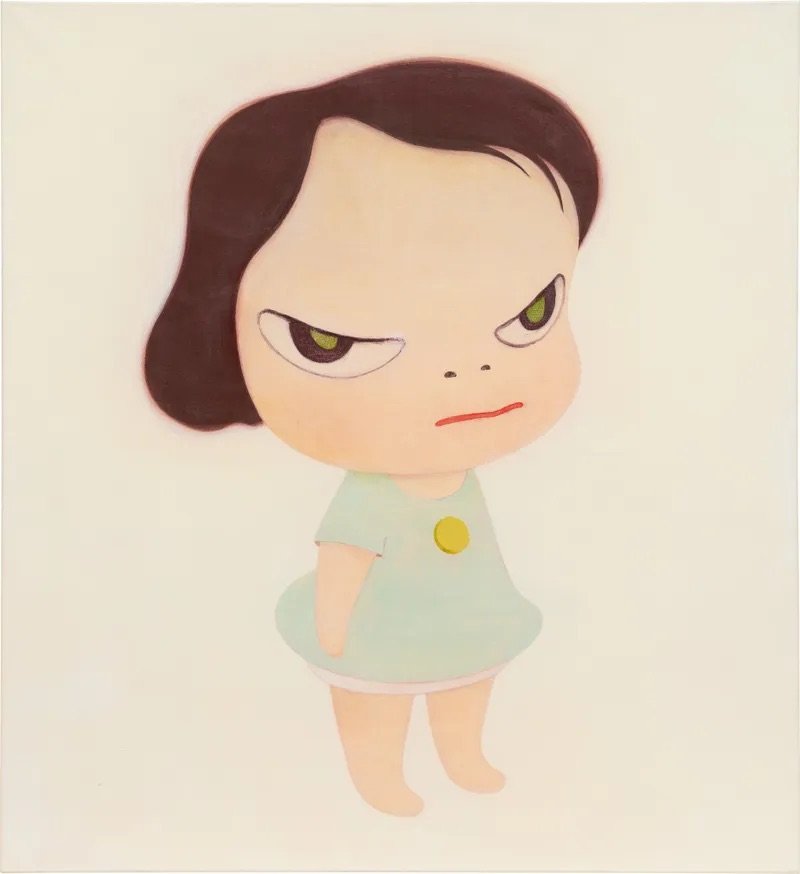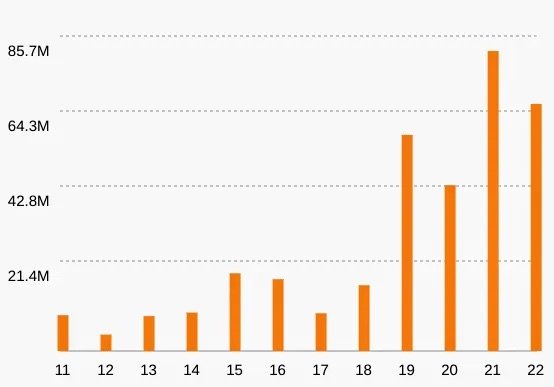Yoshitomo Nara: Asia’s Most Valuable Contemporary Artist
Yoshitomo Nara, a prominent force in Japanese art, has solidified his presence in global collections, captivating audiences worldwide with his singular focus on a captivating subject: a young girl adorned with expressive, oversized eyes.
Words Eric Jurado
“The Little Ambassador” Wall Art Canvas Print | US$8.00 | Yoshitomo Nara Shop
CRAFTING SUPERFLAT MASTERPIECES AND UNVEILING SUBVERSIVE ALLEGORIES
Renowned artist Yoshitomo Nara achieved global acclaim through a distinctive subject: a uniquely identifiable child adorned with stylized features, set against a neutral backdrop. Positioned at the core of the Superflat style, a term coined by Takashi Murakami in 2001, Nara’s creations played a pivotal role in propelling one of the most dynamic postmodern artistic movements. Rooted in inspiration from Edo-period ukiyo-e woodblock prints and the pervasive influence of post-World War II manga culture, the Superflat aesthetic’s obsession with flatness and two-dimensionality thrust contemporary Japanese art onto the world stage, establishing Nara as one of the planet’s most esteemed artists.
Born in 1959 and raised in the secluded town of Hirosaki in northern Japan, Nara’s formative years unfolded amidst vast fields and a solitary countryside upbringing. Amidst the bustling lives of his parents and two much older brothers, his days were filled with music, play with neighbors’ dogs, and the creation of sketches in his notebooks. Transitioning to Tokyo in his teens, followed by a stint in Nagakute for art studies at Aichi University at the age of 21, Nara embarked on a transformative journey to Germany in 1988. Under the tutelage of A.R. Penck in Cologne, he honed his artistic skills at the Staatliche Kunstakademie in Düsseldorf for six years, before returning to Japan in 2000. The mid-1990s witnessed sporadic exhibitions in Nagoya and Tokyo, marking the rapid ascent of Nara’s reputation.
In this early period, Nara’s paintings exhibited thick black outlines, stark colors, and intentionally naive or crude lines reminiscent of manga sketches. However, signs of artistic maturity were already evident. A significant shift occurred in 2000, coinciding with Nara’s return to
his homeland. Transitioning to expansive canvases, he crafted full-length portraits against vibrant pearly backgrounds, exuding refinement without sacrificing a raw quality. By further refining the proportions and features of his iconic child figures, Nara infused them with a captivating enigmatic aura, transcending the notion of mere “cuteness” to convey subversive allegories.
“Frog Girl” | US$12.4 Million | Total Return: 10,285% (17 years) | Annualized Return: 31.4% per year | Sotheby’s Hong Kong, 2021
UNVEILING KOWA KAWAII: NARA’S SUBVERSIVE AESTHETIC REBELLION
Kawaii transcends its translation as “cute” to become a profound Japanese obsession that has permeated every facet of the culture over the past fifty years. It infiltrates even the most solemn official events, challenging the expectation of seriousness. Far more than an adjective, Kawaii embodies a genuine Japanese fixation— a cultivated immaturity that serves as a response to the rigid and immense pressures imposed by school, family, and business.
Originating as a form of protest, this aesthetic is a deliberate return to the spirit of childhood, offering a counterbalance to the demanding expectations of success. It materializes in the form of cute bunnies, lolitas with high socks, and oversized cuddly mascots, promoting kindness, vulnerability, and innocence. However, this seemingly saccharine world, as captured by Nara, is not devoid of subtle rebellions.
Within Nara’s depictions of seemingly sentimental children lies an undercurrent of something “not quite right” or “creepy.” The chubby, sullen-faced girls, with sidelong glances and suppressed anger, carry an unspoken tension towards conflict. Concealing weapons behind their backs, these children are less representations of carefree innocence and more expressions of awareness regarding the dangers of a society under high pressure.
One of Nara’s defining strengths, contributing to his singularity and notoriety, lies in his ability to reinterpret popular traditional and contemporary Japanese art forms while articulating the ambiguous emotions of an often alienated youth. Another remarkable aspect of his artistry is its universal appeal, captivating a wide spectrum of collectors, from influential billionaires to young enthusiasts with modest budgets. Nara’s work serves as a testament to the multifaceted nature of Kawaii, revealing layers of meaning beyond its initial, seemingly innocent facade to Kowa Kawaii, or “creepy-cuteness.”
Nara’s Total Auction Sales per Year in US Dollars | Source: Masterworks
NARA’S SOARING VALUE TRAJECTORY: A CONTEMPORARY ART PHENOMENON
Nara’s ascent in the global art auction arena serves as a vivid reflection of the rapid evolutions within the contemporary art market spanning a generation. From being virtually absent on the radar in 2000, Nara marked a significant milestone in 2014 when his piece “Night Walker” achieved a US$2 million result at Sotheby’s Hong Kong.
However, it was in 2019 that Nara’s prices and international acclaim experienced an explosive surge, yielding impressive total auction sales of over US$50 million, propelling him into the elite ranks of the world’s top 100 selling artists at auction. Yet, his trajectory was far from reaching its zenith.
In October 2019, celebrating his 60th year, Nara surpassed his own auction record during a contemporary art sale orchestrated by Sotheby’s in Hong Kong. Soaring from US$4.4 million for “Sleepless Night (Cat)” in May of the same year, his auction record skyrocketed to US$24.9 million for a commanding canvas dating back to 2000—the year of the artist’s return to Japan after a 12-year stint in Germany. Titled “Knife Behind Back,” the artwork, featuring a little girl concealing a weapon, outstripped the prices of even Takashi Murakami’s finest works.
This marked a significant reversal, establishing Nara as the affable ‘favorite’ contemporary artist among major international collectors. In the span from June 2022 to July 2023, Nara’s total auction sales surpassed an impressive US$97 million, securing his position as the second-highest-grossing contemporary artist, trailing only behind Jean-Michel Basquiat. Nara’s journey signifies not only personal triumph but also underscores the dynamic shifts and preferences within the ever-evolving realm of contemporary art.
“Knife Behind Back” | US$24.9 million | Sotheby’s Hong Kong, 2019
NARA’S ARTISTIC LANDSCAPE: A FUSION OF LUXURY AND ACCESSIBILITY
The realm of Yoshitomo Nara extends far beyond an exclusive enclave reserved solely for affluent collectors. Following a trail blazed by compatriot Takashi Murakami and the iconic Andy Warhol, Nara has embraced a multifaceted approach, presenting his creations in a diverse array of formats and editions, including a range of ‘derivative products.’ Beyond the realm of highly esteemed paintings and sculptures, Nara ventures into the production of plush toy animals, ceramics, lighting, lithographs, limited-edition figurines numbering in the thousands, skateboards, ashtrays, alarm clocks, and even first-aid kits—often in collaboration with American entities such as Cerealart Multiples and Artware.
This strategic move aligns with the economic model pioneered by Takashi Murakami over two decades ago when he established Kaikai Kiki Co. The deliberate blurring of lines between fine art and commercial art has allowed Nara to make his creative works available in various formats, catering to a wide spectrum of budgets and reaching audiences across diverse socio-economic strata. This democratization of art, where Japanese Neo-Pop seamlessly infiltrates consumer culture, has transformed it into a truly international phenomenon.
Yoshitomo Nara with “Miss Margaret” at Albertina Modern, Vienna, 2023 | Image: Artnet
In this unique fusion of luxury and accessibility, Nara, with over a hundred auction results surpassing the million-dollar threshold, paradoxically remains within reach for those with budgets totaling less than ten dollars. His ability to transcend traditional boundaries, making art both a high-end collectible and an everyday indulgence, underscores the dynamic and inclusive nature of his artistic vision.
Caution is advised, and steer clear of unwarranted speculation, as the fervor of collecting can unexpectedly elevate the prices of Nara’s seemingly trivial items; for example, one of his beach towels fetched US$2,645 in June 2023 at Roseberys in London, and another sold for a substantial US$15,000 in July 2021 at Christie’s.
This story first appeared on Art+ Magazine Issue 89. To read more, get the latest issue available on collectibles by artplus, Shopee, and on select stores of National Bookstore and Fully Booked.





